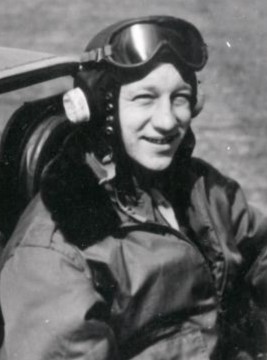Top Qs
Timeline
Chat
Perspective
Donald A. Larson
American fighter ace From Wikipedia, the free encyclopedia
Remove ads
Donald A. Larson (2 April 1915[1][2] or 1917[3] – 4 August 1944) was an American fighter pilot and World War II flying ace from Yakima, Washington. He attained to the rank of major in the United States Army Air Forces while serving with 505th Fighter Squadron, 339th Fighter Group.[4] Larson Air Force Base in Moses Lake was named after him.[5]
Remove ads
Early life
Larson and his identical twin brother Ronald were born in Yakima, Washington, on 2 April 1915.[1] His parents were Alvin N. Larson and Anna D. Larson.[3] He took flying lessons at McAllister Flying School at McAllister Field in Yakima in 1928.[2][1]
Military career
Summarize
Perspective
Larson enlisted as an Air Cadet at McChord Field, Tacoma, Washington, in April[1] or May[2] 1941, where he received his flight training, and continued as a flight instructor. He was assigned to the 339th Bomb Group in 1943. That year, the 339th Bomb Group was moved from Hunter Army Air Field in Georgia to Walterboro Army Air Field in South Carolina, where they flew reconfigured P-39s in as fighter-bombers. Larson went with the 339th as it was moved to Fowlmere, England in April 1944, and began flying P-51s. He was later posted to the 505th Fighter Squadron as a combat pilot.[1]
On 13 May 1944, he shot down his first enemy aircraft, and earned a promotion to major. Only 11 days later, on 24 May, he shot down an additional three aircraft. He earned the ace designation by shooting down his fifth enemy aircraft on 25 July 1944.[1]
During his career, he flew three different aircraft in combat missions: P-51B #42-1066646, P-51D #42-106819 (which he named "Mary Queen of Scotts" after his girlfriend, Mary Scott), and a P-51D #44-13881[3][4] or #13889[1] (also named Mary, Queen of Scotts), which he was flying when he died.[1]
Major Larson commanded an Eighth Air Force fighter squadron. An article dated 7 August 1944 (three days after Larson's death) said that the squadron had claimed "the destruction of 103 enemy planes in 100 missions—54 in the air and the rest aground." The Daily Record continued: "It also claims two enemy planes probably destroyed and 22 damaged."[6]
Remove ads
Death and burial
On 4 August 1944, Larson was on a fighter sweep, and shot down his fifth and sixth enemy aircraft.[2] His P-51D Mustang was also shot down and crashed near Uelzen, Germany. He had flown 57 combat missions.[7] According to some sources, he had destroyed 12 enemy aircraft in his career.[8] His body was initially recovered by enemy forces and buried near Uelzen. After his grave was discovered, his remains were re-interred at the Ardennes American Cemetery and Memorial at Neuville-en-Condroz, Neupré, Wallonia, Belgium, nine miles southwest of Liège.[1][2][7] His grave is in Plot D, Row 11, Grave 9.[4]
Aerial victory credits
- SOURCES: Air Force Historical Study 85: USAF Credits for the Destruction of Enemy Aircraft, World War II
Remove ads
Awards and honors
According to U.S. Representative Hal Holmes of Ellensburg, Major Larson had "been awarded almost all the medals the air force gives".[8] His awards included:
- Silver Star[1][2][4][7]
- Distinguished Flying Cross with Oak Leaf Cluster[1][2][4][7]
- Air Medal with three clusters[1][4][7][note 1]
- Purple Heart[1][7]
- American Defense Service Medal[1]
- European-African-Middle Eastern Campaign Medal with two Bronze Stars[1]
- American Campaign Medal[1]
- World War II Victory Medal[1]
The Air Force undertook a memorialization program to rename many bases in honor of local war heroes. Moses Lake Army Air Base, which operated from 1942 to 1945, reopened on 26 November 1948[2][9] and was renamed to Larson Air Force Base in May 1950 in his honor.[2][7][8][10]
Although the Air Force base was closed down, the section of Moses Lake North that comprises the former base housing continues to be known as the Larson community.
Remove ads
Footnotes
- Fields of Honor and Faces Beyond the Graves only list 2 clusters on the Air Medal. These sources also only list the Air Medal, Silver Star and Distinguished Flying Cross with Oak Cluster.
References
Wikiwand - on
Seamless Wikipedia browsing. On steroids.
Remove ads

